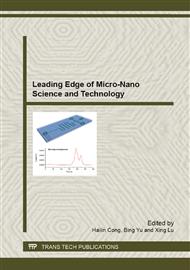[1]
F. Akira, H. Kenichi, Electrochemical photolysis of water at a semiconductor, Nature 238 (1972) 37-38.
Google Scholar
[2]
O. Legrini, E. Oliveros, A. M. Braun, Photochemical processes for water treatment, Chem. Rev. 93 (1993) 671-698.
DOI: 10.1021/cr00018a003
Google Scholar
[3]
A. L. Linsebigler, G. Lu, J. T. Yates, Photocatalysis on TiO2 surfaces: principles, mechanisms, and selected results, Chem. Rev. 95 (1995) 735-758.
DOI: 10.1021/cr00035a013
Google Scholar
[4]
M. R. Hoffmann, S. T. Martin, W. Choi, D. W. Bahnemann, Environmental applications of semiconductor photocatalysis, Chem. Rev. 95 (1995) 69-96.
DOI: 10.1021/cr00033a004
Google Scholar
[5]
A. Kathiravan, R. Renganathan, Effect of anchoring group on the photosensitization of colloidal TiO2 nanoparticles with porphyrins, Journal of Colloid and Interface Science, 331 (2009) 401-407.
DOI: 10.1016/j.jcis.2008.12.001
Google Scholar
[6]
Q. Luo, X. Li, D. Wang, Y. Wang, J. An, Photocatalytic activity of polypyrrole/TiO2 nanocomposites under visible and UV light, J Mater Sci. 46 (2011) 1646-1654.
DOI: 10.1007/s10853-010-4981-7
Google Scholar
[7]
S. Ghasemi, S. Rahimnejad, S. R. Setayesh, S. Rohani, M. R. Gholami, Transition metal ions effect on the properties and photocatalytic activity of nanocrystalline TiO2 prepared in an ionic liquid, Journal of Hazardous Materials 172 (2009).
DOI: 10.1016/j.jhazmat.2009.08.029
Google Scholar
[8]
P. Cheng, C. Deng, M. Gu, W. Shangguan, Visible-light responsive zinc ferrite doped titania photocatalyst for methyl orange degradation, J Mater Sci. 42 (2007) 9239-9244.
DOI: 10.1007/s10853-007-1902-5
Google Scholar
[9]
H. Kisch, S. Sakthivel, M. Janczarek, D. Mitoraj, A low-band gap, nitrogen-modified titania visible-light photocatalyst, J. Phys. Chem. C 111 (2007) 11445-11449.
DOI: 10.1021/jp066457y
Google Scholar
[10]
F. Tessier, C. Zollfrank, N. Travitzky, H. Windsheimer, O. Merdrignac-Conanec, J. Rocherulle, P. Greil, Nitrogen-substituted TiO2: investigation on the photocatalytic activity in the visible light range, J Mater Sci. 44 (2009) 6110-6116.
DOI: 10.1007/s10853-009-3845-5
Google Scholar
[11]
R. Asahi, T. Morikawa, T. Ohwaki, K. Aoki, Y. Taga, Visible-light photocatalysis in nitrogen-doped titanium oxides, Science 293 (2001) 269-271.
DOI: 10.1126/science.1061051
Google Scholar
[12]
K. J. Hoffmann, E. J. Samuelsen, P. H. J. Carlsen, Broken π-conjugated thiophere systems 1. synthesis and polymerization of 2, 2'-di(alkylthienyl) methanes, Synthetic Metals, 113 (2000) 161-166.
DOI: 10.1016/s0379-6779(00)00209-5
Google Scholar
[13]
X. M. Hong, J. C. Tyson, D. M. Collard, Controlling the macromolecular architecture of poly(3-alkylthiophene)s by alternating alkyl and fluoroalkyl substituents, Macromolecules, 33 (2000) 3502-3504.
DOI: 10.1021/ma991997x
Google Scholar
[14]
M. Y. Hua, G. W. Hwang, Y. H. Chuang, S. A. Chen, Soluble n-doped polyaniline: synthesis and characterization, Macromolecules 33 (2000)6235-6238.
DOI: 10.1021/ma000376x
Google Scholar
[15]
W. L. Yuan, E. A. O'Rear, B. P. Grady, D. T. Glatzhofer, Nanometer-thick poly(pyrrole) films formed by admicellar polymerization under conditions of depleting adsolubilization, Langmuir, 18 (2002) 3343-3351.
DOI: 10.1021/la011349i
Google Scholar
[16]
S. Min, F. Wang, Y. Han, An investigation on synthesis and photocatalytic activity of polyaniline sensitized nanocrystalline TiO2 composites, J Mater Sci, 42 (2007) 9966-9972.
DOI: 10.1007/s10853-007-2074-z
Google Scholar
[17]
X. Li, D. Wang, G. Cheng, Q. Luo, J. An, Y. Wang, Preparation of polyaniline-modified TiO2 nanoparticles and their photocatalytic activity under visible light illumination, Applied Catalysis B Environmental 81 (2008) 267-273.
DOI: 10.1016/j.apcatb.2007.12.022
Google Scholar
[18]
F. Wang, S. X. Min, TiO2/polyaniline composites: an efficient photocatalyst for the degradation of methylene blue under natural light, Chinese Chemical Letters 18 (2007) 1273-1277.
DOI: 10.1016/j.cclet.2007.08.010
Google Scholar
[19]
X. Li, W. Chen, C. Bian, J. He, N. Xu, G. Xue, Surface modification of TiO2 nanoparticles by polyaniline, Applied Surface Science 217 (2003) 16-22.
DOI: 10.1016/s0169-4332(03)00565-8
Google Scholar
[20]
L. Zhang, P. Liu, Z. Su, Preparation of PANI-TiO2 nanocomposites and their solid-phase photocatalytic degradation, Polymer Degradation and Stability 91(2006) 2213-2219.
DOI: 10.1016/j.polymdegradstab.2006.01.002
Google Scholar


